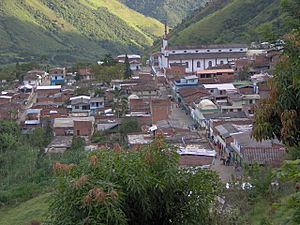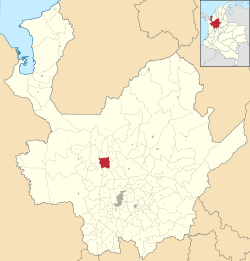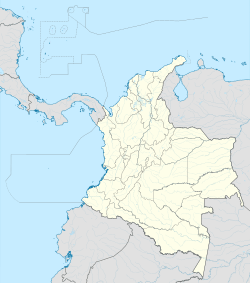Liborina facts for kids
Quick facts for kids
Liborina
|
||
|---|---|---|
|
Municipality and town
|
||

View of Liborina
|
||
|
||

Location of the municipality and town of Liborina in the Antioquia Department of Colombia
|
||
| Country | ||
| Department | ||
| Subregion | Western | |
| Area | ||
| • Total | 217 km2 (84 sq mi) | |
| Population
(Census 2018)
|
||
| • Total | 7,928 | |
| • Density | 36.53/km2 (94.62/sq mi) | |
| Time zone | UTC-5 (Colombia Standard Time) | |
Liborina is a town and municipality in Colombia. It is located in the western part of the Antioquia Department. The town center is about 80 kilometers (50 miles) from Medellín, which is the capital city of Antioquia. Liborina covers an area of 217 square kilometers (84 square miles). It is connected by roads to several nearby towns.
Contents
How Liborina Got Its Name
Liborina was named to honor Liborio Mejía. He was a former Colombian President and a hero of the independence movement.
Geography and Nature
The main water source in Liborina is the Juan García stream. It flows through the municipality from northeast to southwest. Long ago, this stream was called Nutabe or Tajami.
There are two stories about how it got its current name:
- The first and more likely story is that it was named after a Spanish captain, Juan García.
- The second story says it was named after a criminal also called Juan García. He supposedly jumped into the Cauca River from the stream's mouth to escape the police.
The Juan García stream has other smaller streams that flow into it, like La Pava and El Volador.
Liborina is famous for its special "Liborino" beans. These beans are so important that the town even has a festival for them every November! The town is in the mountains, so it has a warm climate that is made cooler by its streams and many trees.
History of Liborina
Long ago, the land where Liborina is now was home to the Nutabe and Tahamí communities. These groups bravely defended their land when the Spanish invaders arrived.
Around 1541, a Spanish explorer named Jorge Robledo passed through the area with his group. However, they did not stay.
The lands of Liborina were given to Francisco López de Rue in 1582. The land was later sold a few times. In 1628, it was bought by a Spanish captain named Juan García de Ordaz y Mancilla. Some parts of the area are still called Juan García today.
Liborina was officially founded on March 7, 1832. It became a municipality in 1833. This happened when the governor of Antioquia at the time, Juan de Dios Aranzazu, ordered its creation.
Don Vicente Londoño was one of the town's founders. He became the first mayor and helped pay for building houses and the market. The first priest was Father Manuel Tirado Villa.
Quick Facts About Liborina
- Founding Date: March 7, 1832
- Became a Municipality: 1833
- Founders: Vicente Londoño, Jorge Martínez, and Rafael Pajón
- Nickname: "Town of Squares"
People of Liborina
In 2018, Liborina had a total population of 10,028 people.
- About 2,296 people lived in the main town area.
- About 7,732 people lived in the countryside.
Most of the people in Liborina are of mixed European and Indigenous heritage (Mestizos & Whites). There is also a group of Afro-Colombians and a small number of Indigenous people.
Economy
The people of Liborina work in different ways to support themselves:
- Farming: They grow crops like coffee, beans (especially the famous Liborino bean), sugar cane, corn, bananas, and various fruits and vegetables.
- Livestock: They raise cattle for meat and milk.
- Mining: Some people work in mining.
- Handicrafts: They also make things by hand, such as shoes and whips.
Tourism and Projects
Liborina is part of the Hidroituango hydroelectric project. This is a large project that generates electricity. The reservoir for this project covers some of Liborina's land along the Cauca River.
The municipality also plans to build smaller hydroelectric projects. One of these, called PCH Liborina, will use the waters of the Juan García stream to make electricity.
Festivals and Celebrations
- Feast of San Lorenzo: Celebrated on August 10.
- Bean Festival: Held every November to celebrate the special Liborino beans.
- Holy Week: Celebrated in March or April, like in many other places.
Places to Visit
- Parish Church of San Lorenzo: A beautiful church in the town.
- Corregimiento La Honda: A rural area with places like The Cross, La Honda Stream, and La Palomera.
- San Diego: A town close to the main center. It is surrounded by mountains and has a nice climate. It is a good place to enjoy local food, especially on weekends. You can also swim in natural pools or go hiking and horseback riding.
Natural Beauty
- Juan García Stream: Known as one of the most active streams in the Antioquia department.
- Angelina Bridge: A notable bridge in the area.
- La Canalón Stream: Another beautiful stream.
- Cerro de La Cruz: A hill with a cross on top, offering great views.
- La Merced del Playón: A town with old colonial streets and lovely natural scenery.
Notable People
- Cesar Maturana
- Jorge David Monsalve
See also
 In Spanish: Liborina para niños
In Spanish: Liborina para niños



